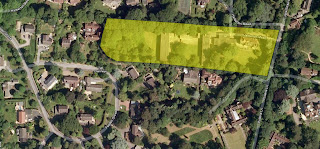Cotuit Hall is the Victorian building on the corner of Pullens Lane and Harberton Mead. Although it’s in a Conservation Area Cotuit Hall is not a listed building. Behind the original Hall, which stands on a narrow plot, there are several newer buildings including two three-storey residential blocks. The whole site is well screened by mature trees. The Headington.org.uk website has the building’s history.
In May 2011 Cotuit Hall was sold by Oxford Brookes University to the EF International Academy, who plan to use it for students aged 16–18 taking two-year residential A-level or International Baccalaureate courses. The Academy is one of several operations run by EF on Headington Hill. EF wants to redevelop and refurbish the site and have appointed architects and planning consultants West Waddy ADP of Abingdon to manage the project. Together they held a small-scale open event on Friday 2 and Saturday 3 March to show their plans to the public. I went along to have a look.
EF wants to retain and refurbish the two existing residential blocks and link them with some new buildings. All the buildings will be lower than the Hall itself. They plan to retain the existing trees which form a mature and in places quite thick boundary around the site. They have surveyed the trees and their root spread so as to define the areas of the site on which building is feasible without damaging the trees. They say that because of the screening and relatively low height of the buildings they will not be intrusive in views of Headington Hill from the City. Access and movement between the buildings will be via a footpath to be built along the spine of the site. The existing entrance on Pullens Lane will remain the only access point, though a second gateway with some degree of security will probably be built inside the site behind the Hall.
I have no strong feelings about the development, and as long as EF and West Waddy’s assurances about the lack of visual intrusion are correct I can’t see any reason to oppose it. Local residents understandably may feel different and might have concerns about student numbers (likely to be over 200), noise and the possibility of anti-social behaviour. However, I think EF’s policy of confining these particular students – 16 to 18 year olds – to the School site during the day and having a number of staff resident on site might help avoid such problems. I’m sure there will be more public discussion on this over the coming months.
Aside from the development I took the chance of speaking to someone from EF about the public disquiet over language school students in Oxford in the summer months. This crops up every year: it comes round in the local papers, radio and tv, the e-democracy forum, my blog, and elsewhere. I last wrote about it in August last year. Since then there has been a meeting between the City Council, Police, bus companies and representatives of some language schools including EF. I encouraged EF to do more to keep in touch with the local community. They should, I believe, take the trouble to explain how they operate: that different EF companies offer different ‘products’ to different customers and not all EF students are the same. But they should realise that to the public EF is still a single brand and bad publicity from one part rubs off on the others. The summer ‘Language Travel’ students, here for just a couple of weeks with minimal time commitment and supervision, are almost certainly responsible for most of the complaints attributable to EF but their behaviour tarnishes all the others.
I want to stress that I am not blaming EF students for all the summer student problems. As I wrote last year there are dozens of language schools bringing thousands of young people to Oxford. EF is just one, but they happen to be in Headington and the students tend to be easy to identify with their branded clothing and accessories so they are very visible to Headington residents. I am sure EF would benefit by engaging more with the local community, by speaking with one voice regardless of which branch of the company is involved, and not hiding behind the screen of “no-one available for comment” which has sometimes happened in the past.
